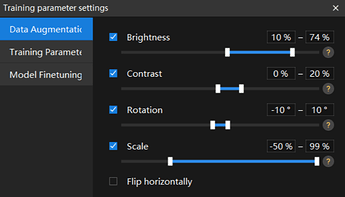In DLK (Deep Learning Kit), data augmentation parameters play a crucial role in enhancing the training data by applying various transformations to the images. These transformations can include random rotations, translations, scaling, flipping, cropping, color adjustments, and more. The purpose of data augmentation is to increase the diversity and variability of the training dataset, which helps the model generalize better and improves its performance.
Will the image not change in real time when adjusting these parameters in DLK?
When adjusting data augmentation parameters in DLK, the changes are typically not applied in real time or immediately visible on the displayed images. Instead, these parameters modify the data generation process during training. Each time an image is used for training, it gets transformed based on the specified augmentation parameters. By adjusting these parameters, you control the magnitude or probability of each transformation. The resulting transformed images are used to train the DL model, while the original dataset remains unchanged.
Here are three examples.
Example 1: I have a cylindrical workpiece. If there is no rotation in the actual incoming material, you can turn off the ‘Rotation’. If there is limited rotation, you can set a fixed rotation angle range.
Example 2: The workpiece always remains on the same plane, and each instance is roughly the same size. In this case, you can decrease the ‘Scale’ parameter.
Example 3: If we need to differentiate labeled mirror pieces, we should not turn on ‘flip horizontally’ or ‘flip vertically’.



